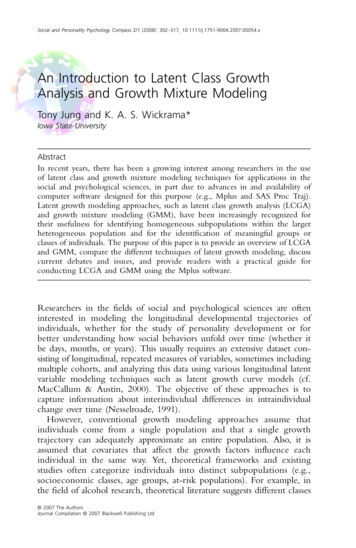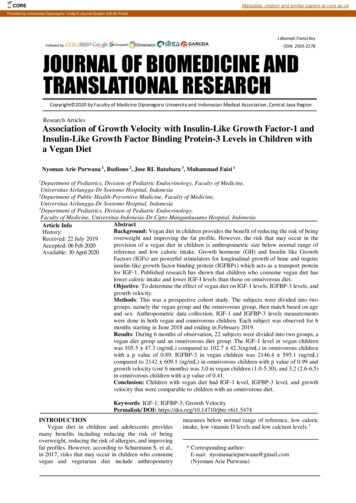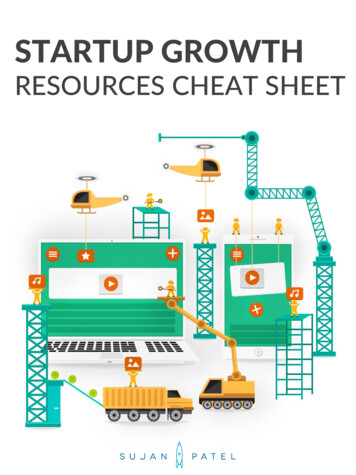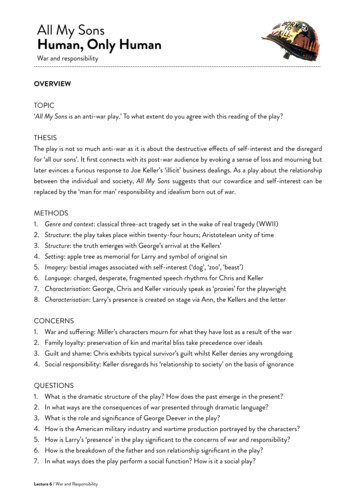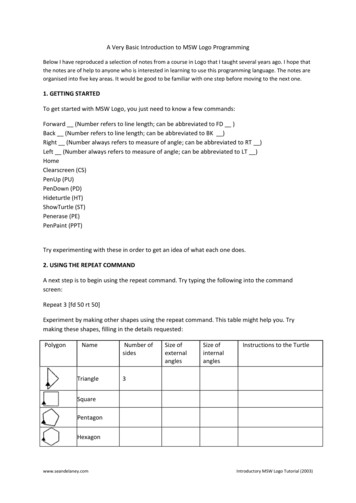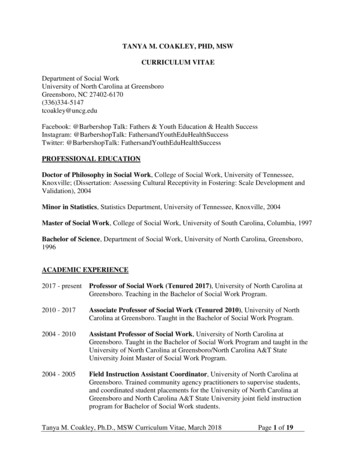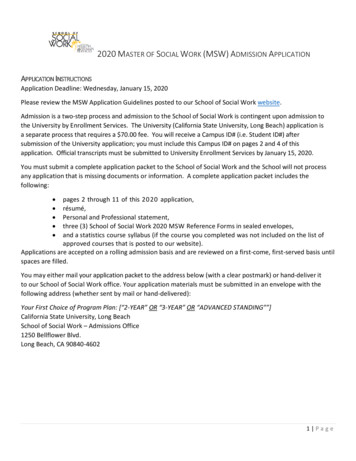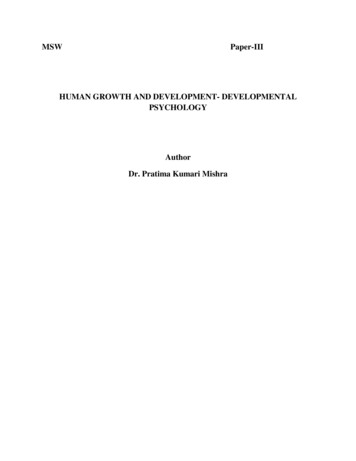
Transcription
MSWPaper-IIIHUMAN GROWTH AND DEVELOPMENT- DEVELOPMENTALPSYCHOLOGYAuthorDr. Pratima Kumari Mishra
SyllabusUnit-I Growth and Development.Psychology: Relevance of Psychology for social work practice, Meaning ofgrowth and Development, Approaches to study of Human Development,Principles of Human Development, Biological influences of Human Growthand Behaviours, Personality Theories, Psychodynamic and BehaviouralTheories.Unit-II Development Stages:Physical, Social and Educational Aspects of the following developmental stageswith special reference to Indian conditions (a) infancy (b) Babyhood (c) EarlyChildhood (d) Late childhood (e) Adolescence (f) Early Adulthood (h) Middle Age(i) Old Age.Unit-III Medical and psychiatric Information.Concept of health and Hygiene. Communicable and deficiency diseases.Unit-IV. Concept of normality and abnormality.Symptoms, causes and treatment of the following Neurosis Psychopathicdisorders and Mental retardation role of Social Worker in promoting health.
UNIT-IGROWTH AND DEVELOPMENT.CONTENTSUNIT-I1.0.OBJECTIVES1.1. PSYCHOLOGY: MEANING AND DEFINITION1.2. PSYCHOLOGY AND SOCIAL WORK: THE RELEVANCE OFPSYCHOLOGY TO SOCIAL WORK1.3. GROWTH AND DEVELOPMENT1.3.1 GROWTH: CONCEPT AND DEFINITION1.3.2. DEVELOPMENT: CONCEPT AND DEFINITION1.4. PRINCIPLES OF HUMAN DEVELOPMENT1.5. FACTORS AFFECTING HUMAN DEVELOPMENT1.6. PERSONALITY: CONCEPT AND DEFINITION1.6.1. THEORIES OF PERSONALITY1.6.2. STRUCTURING PERSONALITY1.6.3. TYPES OF DEFENSE MECHANISMS1.6.4. DEVELOPING PERSONALITY: PSYCHOSEXUAL STAGES1.7. COMPARISON OF PERSONALITY THEORIES1.8. LET US SUM UP1.9. CHECK YOUR PROGRESS
1.0. OBJECTIVESAfter learning this unit, the students will be able to:Define PsychologyImportance of Psychology for social work practiceDifferentiate between growth and developmentLearn about various approaches and principles of human developmentUnderstand the biological influences on human growth and behaviorsKnow about various personality theories of growth and development1.1. PSYCHOLOGY: MEANING AND DEFINITIONPsychology owes its origin from Philosophy. In the year 1950, Rudolf Goecklefirst used the word „Psychology‟. The term „Psychology‟ is a combination of twoGreek words „Psyche‟ and „Logus‟ which mean „Soul‟ and „Science‟, respectively.It has a long history. A review of the history of psychology reveals that during theGreek period philosophers dominated the field of psychology. At that time,Psychology was not a separate discipline. It got scientific status in the year 1879,when Wilhelm Wundt established the first psychological laboratory at Leipzig inGermany. It has been defined differently by different philosophers andpsychologists. The most appropriate definition of psychology has been advocatedby R.S. Woodworth (1910-1960). According to him, “Psychology is the scientificstudy of the activities of the organism in relation to its environment”. Psychologyis a positive science which helps to understand, predict and control humanbbehaviour. It uses scientific methods to study different activities and experiencessystematically. The word „activities‟ includes both external behaviours and internalmental processes. It studies behavior of living organisms, both animals and humanbeings. It acknowledges the role of environment in shaping the behavior oforganisms. Thus, it is concluded that psychology is the scientific study of
behaviours, experiences and mental processes of the organisms in relation to theenvironment.1.2. PSYCHOLOGY AND SOCIAL WORK: THE RELEVANCE OFPSYCHOLOGY TO SOCIAL WORKAn individual lives in a society and different social processes influence theindividual‟s attitudes, beliefs and values etc. As individuals interact with theenvironment and through interaction gain knowledge and experiences, thereforeindividuals‟ behaviours are moulded by the environment.Psychology deals with activities of living organisms whereas social workpractices concerned with the situations where those activities take place.Psychology can make things easier for social worker in order to understand thesituation. It helps the social worker to understand the abilities, attitudes,personality, motivation of the individual and also facilities available in theenvironment of the person with whom the worker is dealing with. It provides anyinnovative solutions to reduce potential problems faced by the social workprofessionals. Social workers can save time and energy to find out the root causesof societal problems by interacting with the person who seeks help, his/her familymembers, friends etc. Social work concerns not only about the individual who usesthe service of the social worker, but it also takes place in a social context. Forexample, the case of a physically disabled person and the situation where theperson stays. The study of the human mind and behavior of the individual help thesocial worker to design an action plan to help the person. Psychology helps a socialwork professional service user in Understanding different activities of the individualKnowing the cause of the particular activityKnowing the positive and negative qualities of the individualUnderstanding intelligence, abilities, attitudes, motivation, aptitudes andpersonality of the person Understanding actions and interactions of the individual in the peer groupand causes of his activities Learning about the situation where an individual is
Understanding his parents and other family members and the rearingprocess Understanding the problems of the individual and seek help1.3. GROWTH AND DEVELOPMENTMost people use the terms „growth‟ and „development‟ interchangeably andaccept them as synonymous. But in reality, the meanings of these two terms aredifferent.1.3.1 GROWTH: CONCEPT AND DEFINITIONGrowth refers to physical increase in some quantity over time. It includeschanges in terms of height, weight, body proportions and general physicalappearance.In Encyclopedia Britannica, growth is defined as “an increase in size or theamount of an entity”. It means growth involves all those structural andphysiological changes that take place within individual during the process ofmaturation. For example, growth of a child means the increase in weight, heightand different organs of the child‟s body.Hurlock has defined Growth as “change in size, in proportion, disappearanceof old features and acquisition of new ones”.Growth refers to structural and physiological changes (Crow and Crow, 1962).Thus, growth refers to an increase in physical size of whole or any of its part andcan be measured.1.3.2. DEVELOPMENT: CONCEPT AND DEFINITIONDevelopment refers to the qualitative changes in the organism as whole.Development is a continuous process through which physical, emotional andintellectual changes occur. It is a more wider and comprehensive term than growth.It is also possible without growth.
In Webster‟s dictionary development is defined as “the series of changes whichan organism undergoes in passing from an embryonic stage to maturity.”In Encyclopedia Britannica is the term development defined as “theprogressive change in size, shape and function during the life of an organism bywhich its genetic potential are translated into functioning adult system.” So,development includes all those psychological changes that take in the functionsand activities of different organs of an organism.Development is continuous and gradual process (Skinner). According to Crowand Crow (1965) development is concerned with growth as well as those changesin behavior which results from environmental situation.”Thus, development is a process of change in growth and capability over timedue to function of both maturation and interaction with the environment.Table 1.1A: Comparison of Growth and Development Growth refers to physiologicalchanges. Changes in the quantitativerespect is termed as growth. Growth does not continuethroughout life. Growthstopsaftermaturation. Growth occurs due to themultiplication of cells. Growth is cellular. Growth is one of the part ofthe developmental process. Development refers to overallchanges in the individual. Itinvolves changes in an orderlyand coherent type towards thegoal of maturity. Development changes in thequality along with quantitativeaspect. Developmentcontinuesthroughout life. Development is progressive. Development occurs due tobothmaturationandinteractionwiththeenvironment. Developmentisorganizational. Development is a wider andcomprehensive term.
Growth may be referred todescribe the changes inparticular aspects of the bodyand behavior of the organism. The changes produced bygrowth are subjects ofmeasurements. They may bequantified and observable innature. Growth may or may not bringdevelopment. Development describes thechanges in the organism as awhole. Developmentbringsqualitative changes which aredifficult to measure directly.They are assessed throughkeen observation of behaviorin different situations. Development is possiblewithout growth.1.4. PRINCIPLES OF HUMAN DEVELOPMENTDevelopmental psychologists believe that knowledge of an accurate pattern ofdevelopment is fundamental to an understanding of children. There are severalbasic principles that characterizes the pattern and process of growth anddevelopment. These principles describe typical development as a predictable andorderly process. Even though there are individual differences in children‟spersonalities, attitudes, behavior and timing of development, the principles andcharacteristics of development are universal patterns.1. Development involves change:- The human being is undergoing changesfrom the moment of conception to the time of death. There are differenttypes of change occur such as, changes in size, proportions, disappearance ofold features and acquisition of new features etc. The goal of thesedevelopmental changes is self-realization, which Abraham Maslow haslabeled as self-actualization. Each individual is equipped with certainabilities and potentialities at birth. By utilizing the innate or inborn abilitiesone tries to realize and strive for self actualization during the total lifeperiod. Children‟s attitude toward change are generally determined by hisknowledge about these changes, social attitudes toward this change and theway people of society treats to children when these changes take place.
2. Development is a continuous process:- Development continues throughoutthe life of an individual. This process takes place in interaction with theenvironment in which a person lives. One stage of development is the basicframework for the next stage of development. A child has limited knowledgeand experiences about his environment. But as he develops, he acquiresmore information through explorations and adds to the skills alreadyacquired and the new skills become the basis for further achievement andmastery of skills. For example, the child is able to write and draw, he musthave developed a hand control to hold a pencil and crayon. Thus, a personhas vast experiences and knowledge as he grows up.3. Development follows a direction and uniform pattern in an orderlymanner:(i)Development proceeds from the center of the body outward. This isthe principle of proximodistal development that describes thedirection of development (from nearer to far apart). It means that thespinal cord develops before outer parts of the body. The child‟s armsdevelop before the hands and the hands and feet develop before thefingers and toes.(ii) Development proceeds from the head downwards. This is called thecephalocaudal principle. According to this principle, developmentoccurs from head to tail. The child gains control of the head first, thenthe arms and then the legs.4. Individual Differences in the Development Process:- Even though thepattern of development is similar for all children but the rate of developmentvaries among children. Each child develops as per his abilities andperception of his environment. Children differ from each other bothgenetically and environmentally. So, both biological factor andenvironmental situations have their impact on individual‟s developmentwhich leads to individual differences in development. Understanding thisfact of individual differences in rates of development should aware us to becareful about using and relying on age and stage characteristics to labelchildren.5. Development depends on maturation and learning:- Maturation refers tothe sequential characteristic of biological growth and development. Thebiological changes occur in sequential order and give children new abilities.
Changes in the brain and nervous system account largely for maturation.These changes in the brain and nervous system account largely formaturation. The child‟s environment and the learning that occurs as a resultof the child‟s experiences largely determine whether the child will reachoptimal development. An enriched environment and varied experiences helpthe child to develop his/her potential.6. Development is predictable:- Human development is predictable during thelife span. Although this development is influenced by both genetic andenvironmental factors, however, it takes place in a pre-defined manner.Specific areas of development, such as: different aspects of motordevelopment, emotional behavior, speech, social behavior, conceptdevelopment, goals, intellectual development etc. follow predictablepatterns. For example, the growth of the child in height and weight etc.continue up to a certain age. In general, it is also found that all childrenfollow a commonality in the development periods of life. All childrengenerally grow following the periods like prenatal period and postnatalperiod. The postnatal period includes infancy, babyhood, childhood, pubertyand so on.7. Early development is more critical than later development:- Miltonwrites “ The childhood shows the man, as morning shows the day.”Similarly, Erikson views “childhood is the scene of man‟s beginning asman.” He explains that if parents gratify the needs of the child for food,attention and love etc. , his perception towards people and situation remainspositive throughout his life. He develops positive attitudes, feels secure,emotionally stable and adjust well with the environment. If negativeexperiences occur during early life of the child, maladjustments may takeplace. Glueck concludes that delinquents can be identified as early as 2-3years of age. Different researchers view that the preschool years age aremost important years of development as basic foundation is laid downduring this period which is difficult to change.8. Development involves Social expectations:- In every society there arecertain rules, standards and traditions which everyone is expected to follow.Development is determined by social norms and expectations of behaviorsform the individuals. Children learn customs, traditions and values of the
society and also what behaviors are expected from them. They realize fromthe approval or disapproval of their behavior.Social expectations are otherwise known as “developmental tasks”.Havinghurst defines developmental task as a “task which arises at or about acertain period in the life of an individual. Developmental tasks arise mainly(a) as a result of physical maturation, (b) form the cultural pressures ofsociety, (c) out of the personal values and aspirations of the individual. Thedevelopmental tasks remain the same from one generation after another in aparticular culture. As societies are evolving, changing traditions and culturalpatterns of a society are learned automatically by children during theirdevelopment process. These developmental tasks help in motivating childrento learn as well as help parents to guide their children.9. Development has potential hazards:- Development may be hampered byvarious hazards. Hazards may be of physical, environmental orpsychological type. These hazards may be originated from the environmentin which the child grows or due to hereditary factors. They have negativeimpact on physical as well as sociopsychological development of the child.The growth of the child may be retarded, he may be an aggressive person orhe may encounter adjustment problems. For example, if a child is slurring orstammering and parents neglect the child, the child may continue with thisproblem.10. Happiness varies at different periods of development:- Happiness variesat different periods in the development process. Childhood is the happiestperiod of life and puberty is the most unhappy. The patterns of happinessvary from child to child and it is influenced by the rearing process of thechild.Paul B. Baltes stated six principles of development of life span approach.The six principles of development are mentioned below:1) Development is a lifelong process- Development is a process whichcontinues throughout life. It begins at birth and ends in death of anindividual.2) Development includes both gain and loss during life span. The childmay develop in one area and lose in another area.3) Development is influenced by the biological factor andenvironmental situations- The human development is influenced by
biological and environmental factors. For example, the body strengthof the child develops in the early period but may deteriorate duringold age.4) Development involves changing allocation of resources. It states thatduring different developmental periods, resources such as; time,money, social support etc. are used differently. For example, duringold age people require more money to maintain their proper health.5) Development can be modified- This principle reveals that throughproper training development can be modified. For example, anindividual can maintain his proper health by doing differentexercises even in old age.6) Development is based upon historical and cultural environment- Thechild grows, develops, acquires knowledge about the traditions,rules, regulations of society according to his historical and culturalenvironment.Development involveschangeDevelopment is acontinuous processDevelopment follows a directionand uniform pattern in an orderlymanner
Individual differences in thedevelopment processDevelopment depends on maturationand learningDevelopment is predictableEarly development is more criticalthan later developmentDevelopment involves socialexpectationDevelopment has potential hazardsHappiness varies at differentperiods of developmentFig. 1.1: Summary of Principles of Human Development1.5. FACTORS AFFECTING HUMAN DEVELOPMENTHuman development is the process in which the changes occur in all theaspects of an organism from conception to death. It is a natural process for eachand every child to grow. But it is observed that all children do not grow in thesimilar fashion. Some children‟s physical growth occur earlier than others, some
are physically stronger than others, some are taller than others and so on. So far asmental development is concerned, some children have better cognitive ability,memory, reasoning, thinking ability etc. than others. All children also do not havesame type of intelligence. Some have more musical talents, others have moreintrapersonal intelligence, others also have more linguistic abilities etc. So,children differ from each other because several factors influence on theirdevelopment. Some of the important factors have been enumerated below:1) Hereditary Factors:- Heredity exerts an influence on human development.The child carries genetic endowments from his/her parents. It is geneticallytransmitted characteristics from one generation to the next. The physicalcharacteristics like height, weight, eye color etc. and psychologicalcharacteristics such as intelligence, personality, creativity and so on areinnately determined and hereditary. The genetic code provides the base onwhich brain and body grow and manifest in observable appearance andbehavior.2) Environmental Factors:- Another important factor of human developmentis the environment where an individual lives. The child lives and grows inhis environment. Environment consists of a wide range of stimuli and itprovides the necessary input and experiential base for development of thechild. Enrichment or impoverishment of the environment would producedifferences in his abilities. For example, a child may have inherited musictalent from his parents through transmission of genes, but he may not excelin music field if he does not get the proper environment and support todevelop his innate ability.3) Home Environment:- Home environment exerts tremendous influence onchild‟s understanding of the external world. It builds self-concept andprepares him to face the external world. The child begins to acquireknowledge through interaction with parents and other family members.During his early years of development, the behaviours of the child aremodulated by the home environment. The environment of the family can besupportive or stressful for the child. If it is supportive, warm andharmonious environment, the child develops normally. In unsupportive andstressful home environment, broken families or uncaring parents in thefamily, children may develop as maladjusted persons.
4) Cultural Factors:- Culture refers to a system of beliefs, attitudes andvalues that are transmitted from one generation to the next. It is a productof past human behavior and is also a shaper of future aspirations. Thedevelopment of the child is influenced by family as well as by the society.The child learns the habits, beliefs, attitude, skills and standards ofjudgment through the socialization processes. The socialization processesof the child take place according to the culture, customs and traditions ofthe society. For example, greeting someone is a familiar experience butbehavioral experiences are different in different cultures. In Indian culture,people greet others by saying namaskar, folding hands or lying down nearthe feet but in Western culture, people greet by handshake or kissing orsaying hello etc.5) Socioeconomic Status (SES):- Socioeconomic Status plays a pivotal role inhuman development. The index of socioeconomic status is determined byparental education, occupation and income. The children of lowsocioeconomic status may develop as mal-nourished, suffer from lack ofknowledge in many aspects and their normal development may gethampered. The parenting in high socioeconomic status families would bedifferent from low socio-economic status families. Children of the highsocioeconomic groups of the society get better social opportunities, arenurtured with better nutrition, good medical treatment and are exposed tomore intellectual stimulation than low socioeconomic group.6) Normative influences:- Normative influences occur in a similar way formajority of people in a particular group. These influences may bebiological or environmental. For example, biological events like sexualmaturity or deterioration in old age. Environmental events, like entering theschool at about 6 yrs of age, parenthood etc. have the same influences onindividuals. Most of the people of the same age, at same place and time andgeneration have common biological and environmental influences such asfloods, famines and other natural disasters. Non-normative influencesinclude the unusual life events in an individual‟s life. For example, death ofa parent when a child is young or birth defects etc.7) Education and Training:- Each child is equipped with certain abilitieswhich need to be nurtured through proper education and training.Therefore, the first and foremost step is to identify and recognize the ability
of the child and the next step is to provide adequate opportunities todevelop the same. If proper identification of the ability is not possible andadequate facilities are not available to the child, then his innate ability maynot be developed. Thus, adequate education and training have influence onhuman development.BIOLOGICAL INFLUENCES ON HUMAN GROWTH ANDBEHAVIORSHuman development is a result of the interaction of biological,cognitive, socio-emotional and ecological processes. Genetic factors are thebasic framework of the biological processes of development. For example,developments of brain, heart, lungs, nervous system etc. ; depend largelyon the hereditary characteristics of the individual. Similarly, changes in theheight, weight, sex characteristics are parts of the biological processes ofdevelopment. Each and every individual tries to keep himself/herself bothphysically and mentally healthy. There are differences among individualsdue to the biological basis of self-preservation. For example, a child who isphysically stronger can overcome various problems that come across in thegrowing up than the less physically strong child. Similarly, the child who isemotionally stronger and stable can face various problems in life than theother child. Thus, physical as well as emotional strength relates to geneticfactors. Due to the genetic factor some children have the desire to livelonger while other children have the death wish is stronger.The biological influences are also observed in the needs of the children. Forexample, a child needs food when he is hungry, he requires water when heis thirsty and so on. These needs are associated with preservation of one‟slife. But how these needs are fulfilled depends upon socio-culturalinfluences. The biology of a person is interlinked with his behaviors. Thus,both body and mind are interdependent. Physical damage can result inmental problems and mental problems may affect physical well-being.As human being lives in a society, with his biological endowments heinteracts with different stimuli of the environment. Social traditions,culture, beliefs, nationality and others influence human behavior. Bothculture and behavior of the individual are inseparable. Thus, human
development and behaviors are combination of biological, social andpsychological influences. For example, a child has talent in mathematics bybirth due to hereditary factor but if the environment does support todevelop his talent, the innate ability may not develop properly.Characteristics of Biological Influences on Human Growth andBehaviors:The human growth and behaviors can be understood from thecharacteristics mentioned below:1) Behaviors are Reproduced in Successive Generations:Behaviors in species are handed over from generation togeneration. In other words, the particular behavior continuesover several generations. For example, goats live to move inflock.2) Change in Biological Process determines Change inBehaviors: The changes in human growth and behaviors aredetermined by changes in biological processes. If there is achange in biological structure or process that leads to changes inhuman growth and behaviors also. For example, if there isdamage in a particular area of the brain of a person, thebehaviors of that person may change as he may express moreaggressiveness or emotionality. Similarly, the intake of certaindrugs may change the brain chemistry which have producedbehavioral changes of human beings.3) Behaviors run in families/ Behaviors are transmitted infamilies: It has been observed in families that if a person in thefamily has mental disorder, other members of the same familymay have same problem to some extent because they carry somesimilar genes which are transmitted over generations.4) Genes are Evolutionary: Behavioral changes occur throughevolutions of genes. The genes of chimpanzees and humanbeings are almost similar. So, chimpanzees are closest to humanbeings and their characteristics and behaviors are more or lesssimilar to humans which can be traced on the basis of history ofevolution of genes.
1.6. PERSONALITY: CONCEPT AND DEFINITIONPersonality is a controversial concept. People used this in various ways. Theterm „personality‟ is derived from the Latin word „Persona‟ which means atheatrical mask used by actors in those days to indicate their role in theatrical play.People usually think that personality means physical attractiveness or reputationetc. So different terms are used to type a person, such as „he is shy‟, „he isintrovert‟ etc. Thus, everyone has got a personality. This personality includes bothouter self and inner self and both of these interact with each other.Several attempts have been made by sociologists, philosophers andpsychologists to define personality in different ways. All these definitionsemphasized on the total person, i.e., his external appearance, his abilities,tendencies, innate and acquired characteristics. Some of these definitions arediscussed below:Coleman (1960) defined personality as “the individual‟s unique pattern oftraits, the pattern that distinguishes him as an individual and accounts for hisunique and relatively consistent way of interacting with his environment”.According to Mischel (1986) personality as “what usually refers to thedistinctive patterns of behavior (including thoughts and emotions) that characterizeeach individual‟s adaptation to the situations of his or her life”.One of the most appropriate definitions of personality has been given byG.W. Allport. He defined personality “as the dynamic organization within theindividual of those psychophysical systems that determine his unique adjustment tohis environment”. Thus, personality is the sum total of physical abilities andmental traits of the individual which are dynamic and they help one to adjust to hisenvironment.Characteristics of Personality1) Personality is unique.2) Personality refers to relatively stable qualities of an individual.3) Personality represents a dynamic orientation of an organism to theenvironment.4) Personality is greatly influenced by social interaction.
1.6.1. THEORIES OF PERSONALITYPersonality theories have been classified into four groups. They are:1)2)3)4)Trait theoriesPsychodynamic theoriesBehavioral theoriesHumanistic theoriesTrait TheoriesTrait theories attempt to describe personality as
members, friends etc. Social work concerns not only about the individual who uses the service of the social worker, but it also takes place in a social context. For example, the case of a physically disabled person and the situation where the person stays. The study of the human mind and behavior of the

